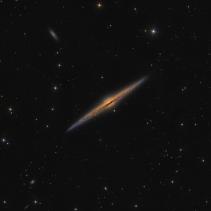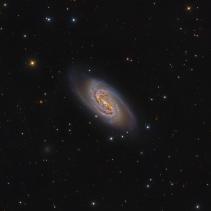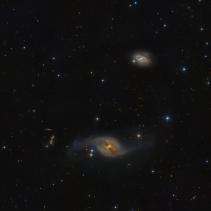Galaxies
Arp 273
Arp 273 is a pair of interacting galaxies, lying 300 million light years away in the constellation Andromeda. It was first described in the Atlas of Peculiar Galaxies, compiled by Halton Arp in 1966. The larger of the spiral galaxies, known as UGC 1810, is about five times more massive than the smaller galaxy. It has a disc that is tidally distorted into a rose-like shape by the gravitational pull of the companion galaxy below it, known as UGC 1813. The smaller galaxy shows distinct signs of active star formation at its nucleus, and "it is thought that the smaller galaxy has actually passed through the larger one.
L = 29 * 600 sec. bin1, R = 12 * 600 sec. bin1, G = 12 * 600 sec. bin1, B = 12 * 600 sec. bin1.
Total - 10.8 hours.
Processing - Pixinsight 1.8 and Photoshop.
NGC 4565
NGC 4565 (also known as the Needle Galaxy or Caldwell 38) is an edge-on spiral galaxy about 30 to 50 million light-years away in the constellation Coma Berenices. It lies close to the North Galactic Pole and has a visual magnitude of approximately 10. It is known as the Needle Galaxy for its narrow profile. First recorded in 1785 by William Herschel, it is a prominent example of an edge-on spiral galaxy.
L = 31 * 900 sec. bin1, R = 12 * 1000 sec. bin2, G = 12 * 1100 sec. bin2, B = 12 * 1200 sec. bin2.
Total - 18.75 hours.
Pixinsight 1.8 and Photoshop.
NGC 2903
NGC 2903 is a field barred spiral galaxy about 30 million light-years away in the constellation Leo. It was discovered by William Herschel who cataloged it on November 16, 1784. NGC 2903 has a very high speed of creating new stars in the central region.
L = 34 * 900 sec. bin1, R = 10 * 1000 sec. bin2, G = 10 * 1100 sec. bin2, B = 10 * 1200 sec. bin2, Ha = 12 * 1800 sec. bin2.
Total - 23.7 hours.
Pixinsight 1.8 and Photoshop.
NGC 3718 & NGC 3729
NGC 3718 and NGC 3729 - galaxy in the constellation Ursa Major.
The most striking is NGC 3718, the warped spiral galaxy. NGC 3718's spiral arms look twisted and extended, mottled with young blue star clusters. Drawn out dust lanes obscure its yellowish central regions. A mere 150 thousand light-years is another large spiral galaxy, NGC 3729. The two are likely interacting gravitationally, accounting for the peculiar appearance of NGC 3718. While this galaxy pair lies about 52 million light-years away, the remarkable Hickson Group 56 can also be seen clustered above NGC 3718. Hickson Group 56 consists of five interacting galaxies and lies over 400 million light-years away.
NGC 3718 and NGC 3729 was discovered by John Herschel in 1828 and 1782 years.
L = 37 * 900 sec. bin1, Ha = 10 * 1800 sec, RGB = 10 * 900 sec. bin2, in the each channel.
Total exposition - 21.75 hours.
Pixinsight 1.8 and Photoshop.




